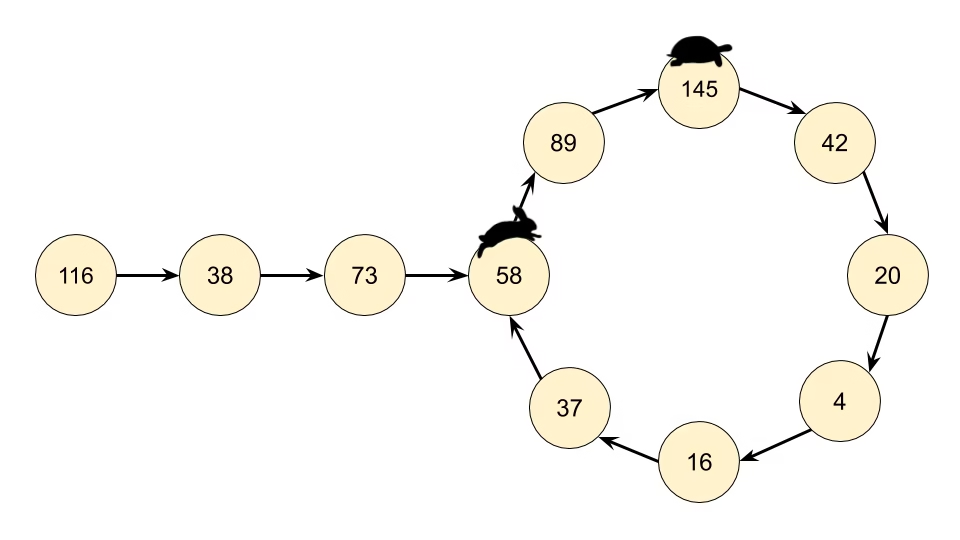Floyd’s Cycle Detection Algorithm is a pointer algorithm that uses two pointers moving at different speeds to detect a cycle in a sequence of values, typically in a linked list. It is one of the most elegant solutions to the cycle detection problem and operates with O(n) time and O(1) space complexity.
This technique was developed by Robert W. Floyd and is widely known as the Tortoise and Hare algorithm, referencing Aesop’s fable.
Table of Contents
Overview
Floyd’s Cycle Detection Algorithm is a powerful technique used to detect cycles in sequences where each element points to the next one. It applies to any structure where you can repeatedly move from one state to the next, including:
- Linked lists
- Iterative function sequences
- Jump arrays
- Functional graphs
Also known as the Tortoise and Hare algorithm, this method is simple yet efficient—running in O(n) time and O(1) space.
What Is a Cycle?
A cycle exists when, starting from an initial element and following transitions (or “next” steps), you revisit a previous element.

Not Valid Cycle
a->b->c->d->e->f
^ |
------How Floyd’s Algorithm Works
Floyd’s algorithm uses two pointers that traverse the sequence at different speeds:
- Tortoise (slow): advances one step at a time.
- Hare (fast): advances two steps at a time.
Algorithm Steps:
- Initialize slow and fast to the starting value x0.
- Repeatedly advance:
- slow = f(slow)
- fast = f(f(fast))
- If slow == fast, a cycle exists.
- If the function reaches a terminal state (e.g., None, or no next), then no cycle exists.
Why It Works
If a cycle exists, the faster pointer will eventually “lap” the slower one inside the cycle—similar to how a faster runner will eventually overtake a slower one on a circular track.
If there’s no cycle, the fast pointer will reach a terminal state and never meet the slow pointer.
Generalized Python Implementation
def floyd_cycle_detection(f, x0):
# Phase 1: Detect if a cycle exists
slow = f(x0)
fast = f(f(x0))
while slow != fast:
if fast is None or f(fast) is None:
return False # No cycle
slow = f(slow)
fast = f(f(fast))
return True # Cycle detected
Finding the Start and length of the Cycle
If a cycle exists, you might want to find its starting point and length.
Step-by-step:
- Run Floyd’s algorithm to find the meeting point.
- Reset one pointer to the start, and move both at the same speed.
- The point where they meet is the start of the cycle.
- To find the cycle length, start from this node and count how many steps it takes to loop back.
General Python Code:
def floyd_find_cycle_start_and_length(f, x0):
# Phase 1: Detect cycle and meeting point
slow = f(x0)
fast = f(f(x0))
while slow != fast:
if fast is None or f(fast) is None:
return None, 0 # No cycle
slow = f(slow)
fast = f(f(fast))
# Phase 2: Find cycle start
slow = x0
while slow != fast:
slow = f(slow)
fast = f(fast)
# Phase 3: Find cycle length
start = slow
length = 1
fast = f(slow)
while fast != start:
fast = f(fast)
length += 1
return start, length
Practice
| Difficulty | Domain | Key Concept / Usage | Problem |
|---|---|---|---|
| Easy | Linked List | Detect if a cycle exists | 141. Linked List Cycle |
| Medium | Linked List | Find start node of the cycle | 142. Linked List Cycle II |
| Medium | Array | Functional graph, detect cycle (duplicate) | 287. Find the Duplicate Number |
| Easy | Math | Detect loop in sum-of-squares sequence | 202. Happy Number |
| Medium | Array | Detect cycle with direction constraints | 457. Circular Array Loop |
| Easy | Linked List | Find middle using slow/fast pointer | 876. Middle of the Linked List |
| Medium | Linked List | Split and merge list using slow/fast pointer | 143. Reorder List |
Conclusion
Floyd’s Cycle Detection algorithm is a beautiful example of a space-efficient solution using clever pointer manipulation. Understanding this algorithm also builds a foundation for solving more complex linked list and pointer problems.
1 thought on “Floyd’s Cycle Detection Algorithm (Tortoise and Hare)”